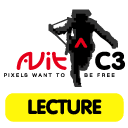21C3 Schedule Release 1.1.7
21st Chaos Communication Congress
Lectures and workshops
| Speakers | |
|---|---|
 |
codeep: Seex |
 |
codeep: Ros Roca |
| Schedule | |
|---|---|
| Day | 3 |
| Location | Workshop |
| Start Time | 11:00 h |
| Duration | 01:00 |
| INFO | |
| ID | 256 |
| Type | Lecture |
| Track | AVIT VJ Conference |
| Language | english |
| FEEDBACK | |
|---|---|
|
Did you attend this event? Give Feedback! |
On finding the score to visuals

To find a standard wich can be used as a medium that can perserve the work of a vj for instituonal conservation and later use, we must first define the form of art that it is. Visuals are determined by several crucial factors that we try to shine light on.
The place and time: Visuals must happen in real time, only the experience of live work that is improvised can evoke the concentration and attention that is needed to enyoy the experience fully. An AV act is therefore closer to performing arts than film or video. A film is meant to be viewed in the form that it was created by the director and his team, an AV act is meant to be performed. Trough performance such a act will change its form each time it is shown, a score like that for music must be developed in order to perserve this art form trough time.
Synergy of sound and visual inputs: The phenomena of finding movement in sound or beat in the picture asks to deconstruct and construct again the stimuli of two human senses. Using the imagination, a human mind is capable of giving meaning, explaining or inventing provided that the right stimulation is supplyed. A vj can help a viewer to find the conection betweene sound and vision, using visual language and vj skills the two can be brought closer together or drawn further appart. This is only one option that a vj has to his disposal, but it is the one that makes the experience of such an act uniqe.
A crew and a public: Like all art forms, audio/visual experiences are created for a spectator. Therefore two sides are nescassary to fulfil the cycle of communication, a crowd of spectators and a crew of performers. The technology that is used as a tool to convey the message alows for some discrapencys in this regard. The AV act can be performed by one person only, but it is much more fun if there is a crowd that is reracting to his/her work in any case. The feedback that is achieved troug live comunication is also one of the factors that affect the qality of the output.
A tool to communicate: Computer technology has greatly efected the development of live visual expression, it has created numerous new possibilities and has made them wiedly avalable. By populising the tool, becouse of its nature it has developed in to so many forms that standarisation is virtulay impossible. New tools are being invented faster than they can be recorded and anyalised, visuals are being created faster than they can be forgotten and contemporary culture is close to creating a blank page in the history of art. Capturing and perserving pixles shuld be the next task that this society shuld bare in mind.
A museum to harbour the art for generations to come: Any society that has developed a museum shuld also find the means to store all forms of art that are being created. Since a live audio visual act has no exsistence but a live recording, it must degraded to the level of a music video or its nearest form of expression. Since a recording only gives clue of a result of such a performance the later spectator is left clules to how it was actualy done. Without defining the tool and technic behind the result a audio/visual performance is impossible to repeat. The repetition of such a act should rather than trough anlyzing the output give a performer a clear idea of what the artist or group of artists were doing to adciheve this result.